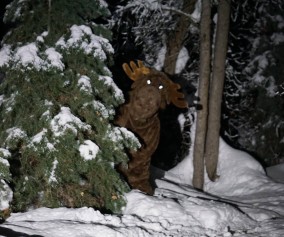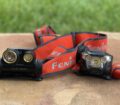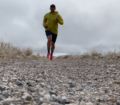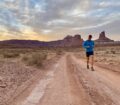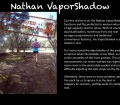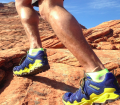A few months ago I did something pretty silly and signed up for the Chimera 100 Miler, a race way out of my league. Instead of backing out, I decided to step up my training and have really enjoyed pushing past my old limits. Last weekend I ran the inaugural Cuyamaca 100K as training for Chimera and to catch any issues that I may need to troubleshoot before my 100 miler.
I’ve run one 100 miler at Rocky Road (much easier than Chimera), and DNF’d another attempt at Nanny Goat 100 (finished 55 miles). I’ve also run a 100K distance at a timed (one-mile loop) event, but Cuyamaca was my first trail 100K.
I finished in 15:42, a great time for me. Aside from some soreness and fatigue at the end, I did better than expected and really saw my training pay off. I’ve taken some time to celebrate a strong finish, and now comes the analysis of my progress and what I need to improve:
6 Things I Did Right
1. Handhelds for Hydration
For a few weeks now, I have been transitioning from a hydration pack, to carrying handhelds for hydration. There have been so many benefits in doing this that I’m working on a separate post about it. When I worry about running out of water, I carry a hydration pack with the bladder removed, and put an extra handheld bottle in it. So I’m always drinking from handhelds only.
For Cuyamaca 100K, I ran with only two handhelds. On the final loop, I carried an extra bottle in my pack but didn’t use it. The handhelds worked perfectly and I never ran out of water. The weather was also perfect and I never felt too hot, so that helped.
One tip I picked up for Gordy Ainsleigh is to carry juice concentrate in one bottle, and mix it with water and salt (small salt packets from any restaurant) in the other bottle. This allows you maximum control as far as diluting your fluids to a perfect consistency. However, you do need a separate water source to do this, such as from an aid station. Gordy usually fills up at streams, sparking some debate with his giardia approach. But that’s a whole different topic!
2. Running Uphills
When I first started trail running, I would try to run all the hills and then get burned out. I soon learned the benefits of power hiking uphill, and fell into a comfortable groove walking pretty much everything with an incline. My most recent hill work has been a combination of speeding up my hiking pace, and actually running uphill again. As a result, I’ve learned that I can run more steeper grades. However, that doesn’t always mean that I should. I’m becoming much better at knowing when to run and when to hike, as well as much more confident in my ability to climb quickly.
3. Blister Prevention
Dealing with blister issues is all about experimentation. For this race, I didn’t use any blister prevention techniques and came out completely unscathed. I attribute this to a wise sock and footwear choice. I wore new trail Injinji socks, and ran most of the course with my Merrell Mixmasters. I switched to my Montrail Rogue Flys in the final loop to vary the feel of my footfalls. This strategy worked perfectly for me.
4. Clothing
I had no chaffing issues at all. I wore longer capris, because on some of the training runs the overgrowth on the trail scratched up my legs. The INKnBURN caprisworked amazingly well.
5. Power Hiking
On my very first trail race, I was shocked when people passed me walking uphill. These past few weeks, I have trained specifically to improve my power hiking speed, using a watch to time my summits and forcing myself to walk, not run. It all payed off in the final stages of this race, when I was able to match my running gait with a fast power hike. The hike conserved energy, I was able to sustain it for a longer period of time, and it allowed me to keep a steady pace through rolling hills even when I felt tired. When my pacer was jogging to keep up with my hiking pace, I knew I had hit a sweet spot for walking speed.
6. Music
I don’t like to listen to music through my entire run, but I do carry my iPod on some races in case I need to pull through a difficult low point. Music really helps get me into a groove, and boosts my motivation. It takes my mind off any pain and makes the time go by faster. When I do listen to my iPod, I like to use only one headphone so I can stay aware of my surroundings. At this race, I busted out my iPod in the last few miles when I needed a boost. It worked.
6 Things I Need to Work On
1. Night Running
I haven’t been doing enough of this. I slowed down a lot after dark, partly because I was tired, but also because I had a hard time with foot placement and navigating terrain at night. Only more practice can help build my confidence and skill in the dark.
2. Nutrition
I did great with remembering to eat, but then started lagging in the final loop and my pacer had to help me with nutrition reminders. I need to be more on top of it, as I was starting to drain right near the end and at one point I even noticed that my stomach was growling. I don’t have much appetite when I’m running, so it’s just a matter of remembering to eat throughout. I didn’t have any stomach issues, except for a couple of times my belly felt slightly “unsettled”, which is usually the case when I don’t eat enough.
3. Lighting
I very much prefer hand held lights to a headlamp, but I didn’t think through the fact that I would also be running with hand held water bottles. I had a hard time holding everything. I also had a headlamp, but I need to combine it with something else for better depth perception. A few times my hand would start cramping up and I had to keep shifting my hand position to hold everything. It was a waste of focus and energy. My coach Jason Robillard also runs with handheld bottles, plus a handheld light. So it can be done. I just have to practice doing this more often.
4. Sore Feet
Many of my long races have been on smoother terrain, so this was the first time my feet got sore from gnarly rocks in the final miles. I wrote to Jason Robillard about this, and he suggests that it’s worth taking a few extra seconds to avoid sharp and jutting rocks from the beginning of the race (even though they don’t hurt yet), to help preserve your feet for the later miles. Minimalist shoes are an added challenge, but I don’t do well with heavier shoes. Again, more practice on rockier terrain will help me improve. As mentioned before, the shoe swap was a really great call for me during this race.
5. Downhill Running
Usually running downhill is my strength, but in the final loop my legs felt pretty trashed and it was a new feeling of discomfort for me. My 100 miler was much flatter, and I have little practice running downhill on trashed legs. Jason suggested changing up my gait for the downhills, and throwing in some more hill training. I think both will help.
6. Suck It Up
I thought I was pushing myself pretty good, but of course after the fact I wonder if I could have pushed a LITTLE harder in the final miles. I did a lot of walking in the final loop, and I maybe should have done more running while it was still light, since the darkness would slow me down anyway. If I had to do it again, I think I would have dug a little deeper right at the end. And next time I will.
Overall, I had a great race and it was a perfect learning experience for Chimera . I’m not quite where I want to be, but I’m much closer than I used to be.
Vanessa’s original article is posted at her site VanessaRuns.com







